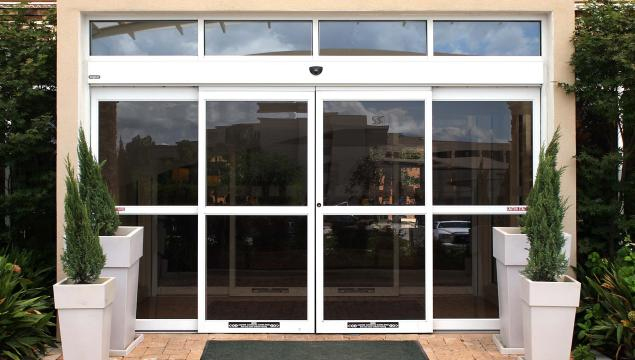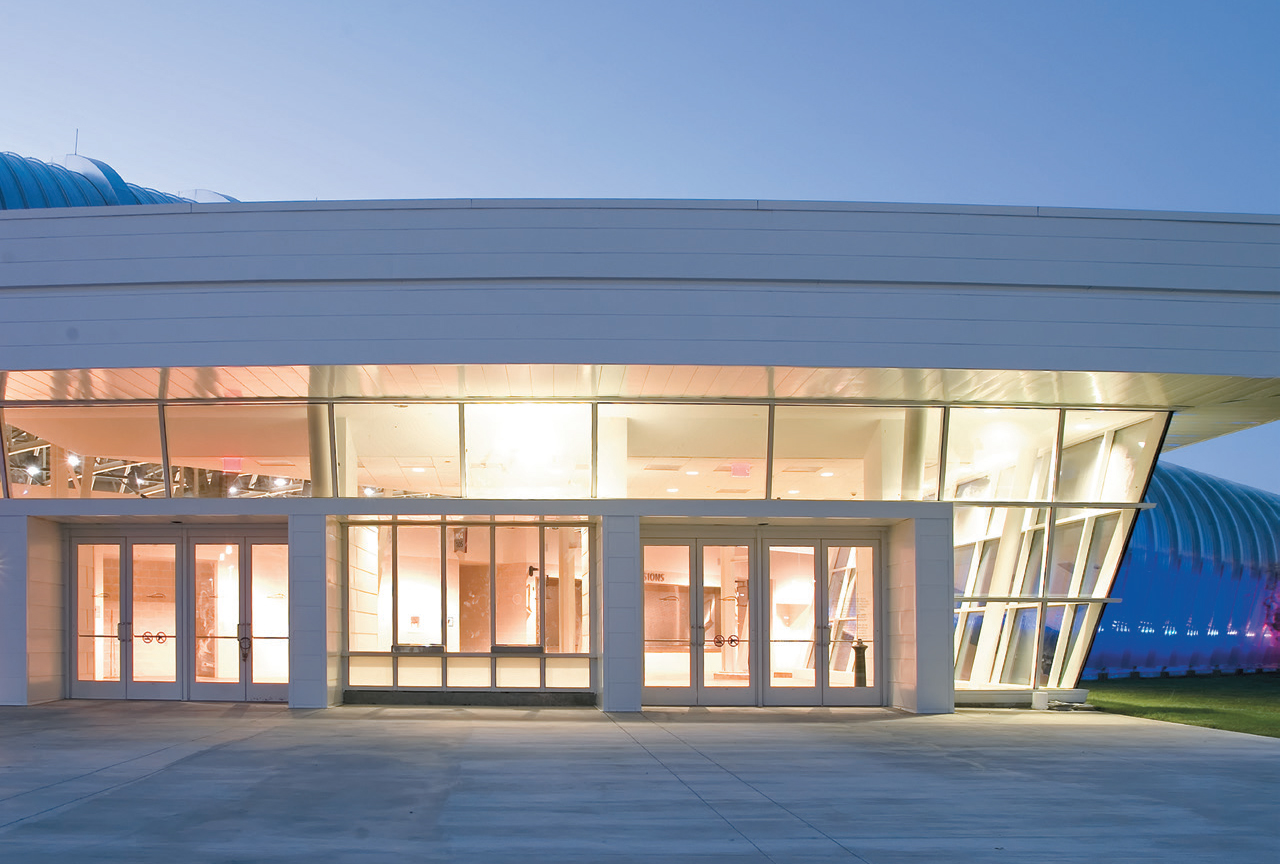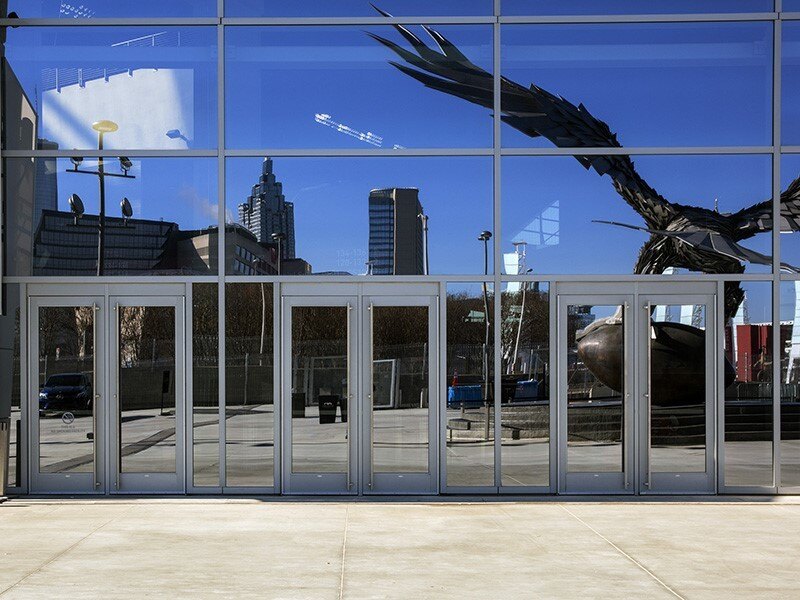When specifying a storefront door, key considerations include security, accessibility, durability, aesthetics, energy efficiency, functionality, ease of maintenance, and compliance with
local building codes and standards. These factors collectively contribute to a successful and effective commercial storefront door design.
Types of Commercial Storefront Doors
Common types of commercial storefront doors include hinged/swinging doors, sliding doors and folding doors, each chosen based on space, design, and accessibility requirements.
Swinging Doors
Architects frequently specify a swinging storefront door for its simplicity, cost-effectiveness, and ease of installation. Swing doors are a common choice when the design and functionality align with the project's requirements, especially in smaller commercial spaces with straightforward accessibility needs.
Sliding Doors
Opting for a sliding storefront door can be beneficial when space is limited, as it requires no swing clearance. Sliding storefront doors have a modern aesthetic, smooth operation, and suitability for high-traffic areas. They can create an open, inviting feeling for a commercial space while offering ease of use for customers and visitors.
Folding Doors
Folding storefront doors are favored for their versatility because they have wide openings for seamless indoor-outdoor transitions. They offer an aesthetically pleasing, contemporary appearance and are valued for the ability to create expansive, unobstructed openings. This feature allows businesses to adapt their space to various needs, such as hosting events or accommodating large groups of customers.
Commercial Storefront Door Material Selection
Storefront doors offer a wide range of material options to meet specific design, durability, and functionality needs. Architects and designers can choose from materials such as aluminum, glass, and wood to achieve the desired aesthetic and performance in commercial spaces.
Aluminum Doors
Aluminum is a popular material for storefront doors. Aluminum doors, both with and without glass panels, are lightweight, which makes them easy to install and operate. Aluminum's natural resistance to corrosion ensures longevity and minimal maintenance. As a highly recyclable material, they also offer sustainability benefits. Aluminum doors can contribute to LEED certification by promoting energy efficiency through insulated versions and by reducing overall environmental impact.
Glass Doors
Glass storefront doors can create an inviting, well-lit atmosphere in commercial spaces. They enhance visibility, attract customers and showcase products. Glass doors provide a modern and appealing look that adds sophistication to storefronts. They can also contribute to energy efficiency when paired with insulating glass that helps regulate indoor temperatures and reduce energy costs. Glass storefronts offer versatility in design and can be customized, which makes them a favored choice for businesses and public buildings.
Wooden Doors
Wood storefront doors offer timeless elegance and warmth to commercial spaces. Wood adapts easily to unique designs and finishes. Wood storefront doors may require more maintenance than other materials, but the natural beauty and charm of wood can be easily customized to virtually any architectural style. When selecting wood storefront doors, architects and designers should consider weight, which can be heavier than other materials, and the potential impact on ease of operation. Proper hardware and support systems should be in place to ensure smooth opening and closing, especially for larger or solid wood doors. Security
Features of Commercial Storefront Doors
As you are selecting a storefront door, security features should be considered. These include advanced locking systems, impact-resistant glass, access control measures, such as keyless entry or card readers, and even alarm integration.
Assessing these security aspects ensures optimal operation combined with the safety of the premises and its occupants.
Locking Mechanisms
When choosing a storefront door, security should be prioritized with robust locking mechanisms such as mortise locks or multipoint locks, which offer superior protection against unauthorized entry. Access control systems, including keyless entry or biometric access, can enhance security by limiting who can enter. Additionally, integrating the door into a broader alarm system can produce an alert for breach notification. Reinforced frames and hinges can also be used to bolster the door's resistance to forced entry. A secure storefront door not only safeguards the premises and property inside, but also the occupants.
Impact Resistance
Impact resistance features can significantly enhance the performance, safety, and security of storefront doors. Many commercial storefront doors are designed to withstand physical force, such as attempted break-ins or impacts from severe weather events. Impact resistance ensures the door remains intact and functional, by reducing the risk of unauthorized entry while protecting occupants. Impact-resistant glass, for example, is less likely to shatter upon impact, which can help to prevent potential injuries and maintain visibility. Impact-resistant materials are available that are rated to withstand the forces of hurricanes and severe storms, for enhanced safety during extreme weather conditions.
Energy Efficiency
Storefront doors enhance energy efficiency by serving as a barrier against heat transfer and air leakage. Properly designed and installed doors help maintain indoor temperatures, reduce heating and cooling costs, and help to create a comfortable and sustainable building environment.
Insulating Glass
Storefront doors with insulating glass are designed to reduce solar gain by incorporating low-emissivity (low-E) coatings and inert gas fills between glass panes. These features limit the amount of heat and UV radiation that enters the building and help to maintain a comfortable indoor temperature and reduce the need for excessive cooling, thus improving energy efficiency. This same design configuration helps to dampen sound transmission by creating a barrier that blocks and absorbs sound waves. The result is a quieter indoor environment, making doors with insulating glass ideal for locations where noise reduction is essential, such as busy streets or high-traffic commercial areas.
Weatherstripping
Weatherstripping for storefront doors provides a tight seal around the door frame, to prevent drafts, moisture, and outside elements from entering indoor spaces. It enhances energy efficiency by reducing heat or cool air loss. Weatherstripping can also improve the operation of a storefront door by reducing friction and wear, for smoother and quieter door movement. It also helps to maintain the door's alignment, and prevent misalignment issues that can affect door function over time.
Accessibility and Compliance
Storefront doors can enhance accessibility and compliance with features such as automatic or easy-to-operate mechanisms, and proper width and clearance for wheelchair users. These elements ensure that doors meet accessibility standards, in order to provide equal access to all individuals and to comply with disability laws.
ADA (Americans with Disabilities Act) Compliance
Storefront doors are integral to ADA compliance in a public setting. Compliant storefront doors feature clear passage widths of at least 32 inches, smooth and easy-to-operate hardware, and low thresholds to facilitate wheelchair access. They incorporate tactile signage for those with visual impairments, contrasting colors to aid those with low vision, and proper maneuvering clearance. Automatic or push-button door openers can further enhance accessibility. These features will ensure that storefront doors meet the standards set by the ADA to provide equal access and accommodate individuals with disabilities.
Local Building Codes
Local building codes must be carefully adhered to when selecting storefront doors. They govern aspects such as door size, egress requirements, accessibility standards and fire safety. They may mandate specific materials or insulation levels to meet energy efficiency regulations for specific geographic regions. Wind-load and hurricane resistance requirements can also vary by location.
Seismic considerations may also influence the choice of door and its anchoring system. To ensure safety, accessibility, and overall building performance, architects should thoroughly understand and comply with local building codes when specifying storefront doors. Failure to do so can lead to compliance issues, costly alterations, or delays during the construction process.
Commercial Storefront Door Examples

Stanley® Dura-Glide® Sliding Doors are among the most popular commercial sliding doors available. In life-or-death situations, like emergency rooms, reliable performance is critical. DuraGlide sliding doors are known for their reliability, security, and convenience. They offer smooth and quiet operation, making them ideal for high-traffic commercial spaces.
These doors enhance energy efficiency with insulated glass options and reduce the transfer of outside noise. They also have various safety features, like obstacle detection and emergency egress, to ensure compliance with building codes. Customizable designs and finishes allow architects to integrate them seamlessly into diverse architectural styles while providing a welcoming and accessible entrance.

Kawneer 190, 350, and 500 Standard Entrances seamlessly combine durability and aesthetics. These aluminum storefront entrances, featured in the Garland Special Events Center, Garland, Texas, are available as a complete package with doors, door frames, and hardware that is adaptable to custom needs. They suit various architectural styles, whether modern or traditional, in both new construction and renovations. These swing storefront doors are rigorously engineered to create lasting impressions while enduring constant use by building occupants and visitors.
They come in a wide range of painted finishes in order to meet AAMA 2605 standards, and can be customized in an unlimited number of specially designed colors. Solvent-free powder coatings meet AAMA 2604 standards for green and durable options.
Selecting the Best Commercial Storefront Door with Acelab
Acelab is a cloud-based collaboration platform that offers a range of tools and resources to help architecture professionals research, compare, and select building products for their projects. With Acelab, users can access product data, technical specifications, and CAD details from leading manufacturers, as well as tools to create and manage project libraries, product lists, and specification documents. Acelab is designed to help architecture professionals save time and streamline their workflows by providing a centralized source of information and tools for building product research and specification tasks.

